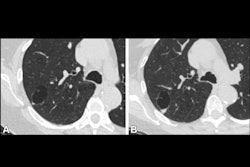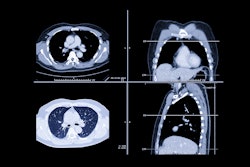Lung cancer screening (LCS) guidelines should include occupational exposure criteria for people such as firefighters, according to a study published August 20 in Lung.
A team led by Savan Shah, MD, of Rush University Medical Center in Chicago reported that, among a cohort of 1,347 firefighters who underwent low-dose CT imaging (LDCT), only 14.6% were eligible for the test according to U.S. Preventive Services Task Force (USPSTF) recommendations -- even though some were found to have high-risk lung nodules that required intervention or surveillance.
"Firefighting is known to be carcinogenic to humans," the group wrote. "However, current lung cancer screening guidelines do not account for occupational exposure."
Tobacco smoke is the most common risk factor for lung cancer, but exposure to carcinogens also increases risk, the team noted, writing that firefighters "may be exposed to carcinogenic building materials such as asbestos, diesel fumes, combustion products of fires, chemicals in firefighting foams, and more."
Shah's group sought to clarify any associations between firefighters and lung cancer risk via a study that included data from 1,347 firefighters (median age, 51) recruited from the Chicago Fire Department Local 2 Union who underwent lung cancer screening between April 2022 and June 2023 as part of a pilot program established by the university. Of the study participants, 66.7% were never smokers, 25.6% were former smokers, and 7.7% were current smokers.
The investigators found the following:
- Among the firefighters who underwent LDCT, 1,339 (99.4%) were discovered to have a lung nodule.
- Forty-one (3%) firefighters had high-risk (Lung-RADS 3 or 4) nodules that required intervention or surveillance.
- Of these firefighters with high-risk nodules, 17.1% required intervention (video-assisted thoracoscopic surgery, biopsy, endobronchial ultrasound and biopsy, bronchoscopy, or minimally invasive lung resection), but only 14.6% were eligible for lung cancer screening based on current guidelines.
- LDCT identified seven high-risk nodules (0.5%) that required procedural intervention, and six (85.7%) of these were found in individuals not eligible for screening.
- Of firefighters with high-risk nodules, 57.1% were never-smoking individuals not eligible for screening.
These study findings suggest that "carefully selected occupational exposures should be considered in the development of future lung cancer screening guidelines," Shah and colleagues wrote.
"Based on the results presented here, firefighters of any age or smoking history may benefit from LDCT lung cancer screening," they concluded.
The complete study can be found here.




















